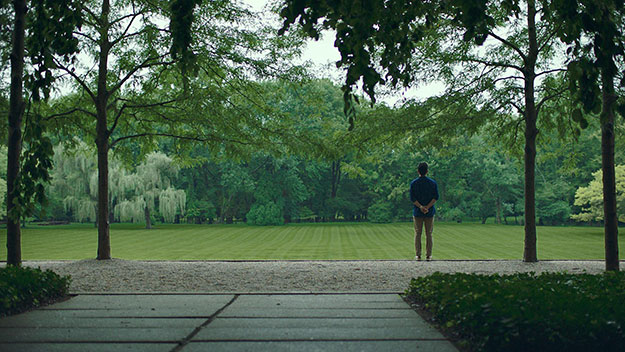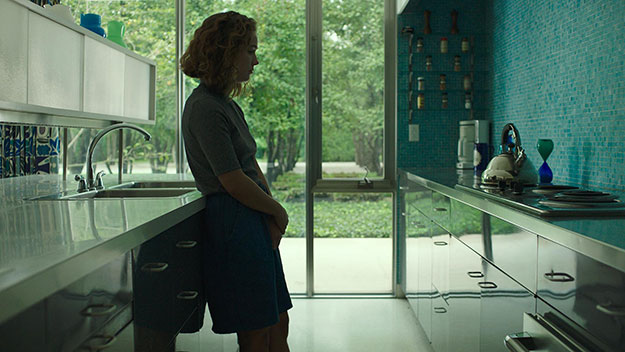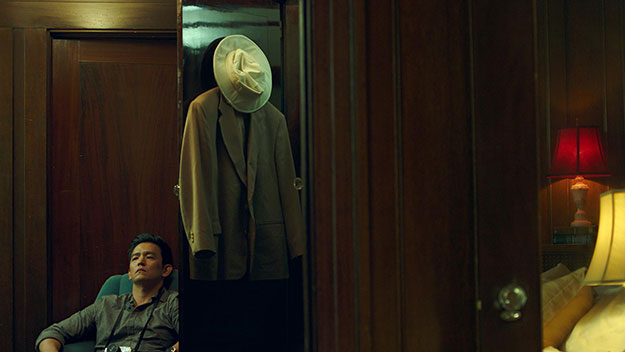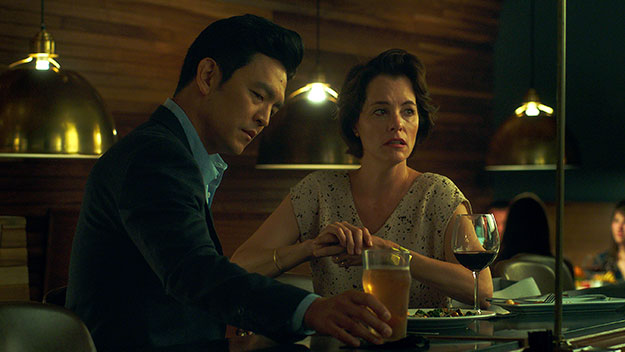Film of the Week: Columbus

“Writing about music is like dancing about architecture,” as the saying goes (sometimes attributed to Elvis Costello, although the real source is reportedly humorist Martin Mull). The American independent feature Columbus is possibly as close to dancing about architecture as you can get; it’s certainly a film about the way that architecture can make the soul dance, although when the heroine actually dances, it’s not about architecture at all, but emerges in a flurry of frustration, rage, and self-doubt. This is one of the few moments in Columbus that you’d conventionally expect to find in an American small-town coming-of-age movie (which this only partly is), and the only moment of unfettered expressivity in a film that’s otherwise defined by stately restraint. Even so, Columbus is intensely moving—only you have to be prepared to slip between the lines of its perfectly formed geometry to find the sources of its emotion.
Columbus, which premiered in Sundance this year, is a strikingly distinctive film, and one of the best American debuts in ages. It is also unfashionably cerebral—but it’s a manifesto for a cinema in which thoughtfulness, even intellectualism, is in no way exclusive of feeling, even of passion. It is the work of Kogonada, a Korean-American writer-director best known for his online “supercuts”—inventive, exploratory essays on the themes and styles of directors including Kubrick, Godard, and (a contemplative pair perhaps most pertinent to Columbus) Ozu and Kore-eda. This might lead you to expect that his debut feature would be some studious work of film-buff clever-dickery, but Columbus’s awareness of human character and of the way people inhabit their everyday worlds gives the film a very mature richness.
The setting is Columbus, Indiana, a city gifted with an unusually high concentration of notable modernist architecture (it’s also the birthplace of Mike Pence, but nowhere’s perfect). The heroine is Casey (Haley Lu Richardson), a 19-year-old girl from a working-class background; recently graduated, she’s currently working in the local university library, but isn’t sure what to do with the rest of her life. She also works as a tour guide, informing visitors about the local buildings which are her passion; most people in town, she says, don’t even notice these extraordinary edifices by the likes of Eero Saarinen, I.M. Pei, Deborah Berke, and Robert Venturi, which she enthuses about with a rapturous fan’s ecstasy. Casey could—probably should—study architecture, but she’s reluctant to leave town, as she’s protectively, or possessively, committed to keeping an eye on her mother (Michelle Forbes), a single woman with a day job in a factory, a night job cleaning, and a history of drug problems.

The other main character is Jin (John Cho), a Korean translator who has spent time in the States but now lives in Seoul. He’s come to Columbus because his elderly father, a leading architecture professor, has fallen ill. The setup for this at the film’s start is extraordinary: DP Elisha Christian’s camera gives us a series of frontal, perfectly composed shots of Saarinen’s austerely palatial Miller House, its rectilinear geometry suggestive of a series of Mondrian grids. The professor, seen only at a distance, standing outside under an umbrella, wanders off and out of shot, until the woman accompanying him—architecture academic Eleanor (Parker Posey)—rushes towards him in a panic.
Arriving in town, Jin checks into his father’s room in the sumptuously chintzy Inn at Irwin Gardens, where he reunites with Eleanor, his old flame; Kogonada, who edits Columbus himself, elegantly interweaves two scenes here, cutting between Jin alone in his room and Jin with Eleanor at the hotel bar. It’s the sort of graceful, unflashily inventive touch that the film abounds in.
Then Jin and Casey meet over shared cigarettes (the film proudly reclaims smoking as a form of social cement). Little by little, as she introduces him to the city sights and communicates her passion for architecture—an art he claims to be indifferent to—they come to reveal their souls and their insecurities to each other, two very different people with different backgrounds, but united by the fact that both have difficult parents and futures to worry about. Despite a night that Casey spends in Jin’s hotel bed—he sleeps fully clothed on a chair, a whisky bottle just casually visible in shot—it seems to be an entirely chaste relationship. These are two people who might be attracted to each other, but have a sort of surrogate father-daughter connection—and in any case, have other emotional fish to fry. The film is not unlike a small-town rewriting of Lost In Translation, at a stretch, but without the facetiousness, without the strident cultural tourism, without the sentiment straining beneath the surface.

The lead duo are beautifully cast. Cho, till now known as a mainstream player (Sulu in the new Star Trek films, an American Pie regular, half of the Harold and Kumar duo) reinvents himself as a thoughtful, elegant, reserved kind of young elder statesman, giving the urbane Jin a slightly sour, brittle edge. Haley Lu Richardson—seen in The Edge of Seventeen and M. Night Shyamalan’s monumentally silly Split—is superb playing a type of character rarely seen these days in American cinema, someone with an untarnished propensity to intellectual and aesthetic rapture. There’s an extraordinary moment when Casey and Jin are standing in front of one of her favorite buildings, a glass-fronted bank, and he asks her to describe what it makes her feel: Kogonada cuts to her through the glass, and we don’t hear a word she says, only see the expression on her face and her gestures, as she looks for the words she needs. Richardson’s face and physical presence are as much a marvel as any of the buildings and spaces in Columbus: dressed in shapeless student clothes that make her look slightly ungainly, physically hesitant, Richardson has a candid face that simply glows in close-up, her shiny, tanned features illuminated by uncynical enthusiasm.
Kogonada, both as director and editor, has a talent for catching people’s emotions at their most delicately revealing. When Casey asks Jin to come and join her on a night tour of the town, Kogonada cuts away just at the moment her eager smile starts to fall away, perfectly catching a note of neediness. An intimate moment between Jin and Eleanor in her hotel room is shot with the two of them only seen framed in a mirror; when Jin leaves, he’s framed in a different mirror.
It’s a meticulously composed film—an architected film. One leitmotif is corridors—of the hotel and of Casey’s house, but also of the semi-rural back streets of the working-class district where she lives (the film is astutely understated in signaling that Columbus isn’t just the manicured, privileged utopia that it may seem). Kogonada likes visual rhymes—the opening shots with Eleanor and the Professor at the Miller House later replay themselves between Casey and Jin. The Miller House is Mondrian-like at the start, and Kogonada reinforces the impression in shots of an office corridor, where primary color Post-It notes on the wall recall that artist’s signature palette. Not that these formal patterns are obtrusive, but it’s almost as if somewhere in its DNA, Columbus contains a hidden Kogonada supercut of itself.

Kogonada’s dialogue, however, can sometimes feel too knowing, as if the characters’ ironic intelligence is guarding against too direct emotion, and the effect can be a little arch. In a scene where Eleanor reminds him of his filial responsibility (Parker Posey’s trademark nerviness, by the way, is superbly, delicately tuned in this film), Jin retorts: “You’ve been watching too much Korean drama.” When Casey talks about her mother, she and Jin toss around his line, “Your mother? Did she do meth?” like an absurd object that neither of them really want to handle; it feels like an awkward disavowal of real feeling.
But in another self-reflexive register, this is also a film that is unashamedly about aesthetics and thought—and in some ways, very much about itself. Columbus wryly signals its espousal of subtlety when Casey tells her mother that the meal she’s just cooked her is “something a little less obvious. You can taste the food better and there’s a better aftertaste.” And there’s a singular scene in which Casey’s library co-worker (a quietly personable Rory Culkin) tries to explode the myth about dwindling attention spans. The contemporary crisis, he concludes, is not in people’s ability to concentrate, but in their ability to be interested. “Are we losing interest in everyday life?” is the payoff of this discussion. Kogonada—an admirer of Ozu and Kore-eda, remember—clearly isn’t losing interest, certainly not in this scene, punctuated by shots of a garden sprinkler, its sound mixed with the muted throb of music from a gardener’s earphones.
If Columbus has a revelation to impart, it’s about the pleasures of the everyday, and about the way that the monumental, the extraordinary, can merge with the everyday to the point almost of disappearing—which isn’t always a bad thing. Columbus appears almost to be two cities folded into one: some shots reveal it as a mundane place, with traffic and rundown back streets, but that place co-exists with the enchanted, seemingly enclosed garden of wonders that the film explores. Kogonada and Christian constantly find new ways to highlight the miraculousness of this landscape—isolating the marble surfaces at the Veterans Memorial, catching Saarinen’s hexagonal North Christian Church across a stretch of park, or catching the two vertiginously suspended arms of brick at City Hall. But the film just as often lets these sights fold into the ordinary landscape of Casey’s everyday rut.

At one point, Cho’s Jin delivers a perhaps too overt observation: “This isn’t a movie. Nothing’s going to happen.” Nothing much does, although it’s slightly disappointing that, right at the end, Kogonada gives us a more conventionally cathartic pay-off than you might expect—hell, there’s even a hug. It doesn’t matter—that (admittedly minor-key) turn towards the familiar may, with any luck, buy Kogonada the license to make further subtle, elliptical features in the future. And having seen and loved Columbus twice now, I can assure that it’s true—it does give you a better, and longer-lasting, aftertaste.
Columbus opens August 4.
Jonathan Romney is a contributing editor to Film Comment and writes its Film of the Week column. He is a member of the London Film Critics Circle.







